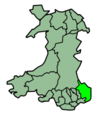Abergavenny railway station
Abergavenny Add→{{rail-interchange}} | |
|---|---|
| General information | |
| Other names | Welsh: Y Fenni |
| Location | Monmouthshire |
| Managed by | Arriva Trains Wales |
| Platforms | 2 |
| Other information | |
| Station code | AGV |
| Key dates | |
| 2 January 1854 | Station opens |
| 19 July 1950 | Renamed Abergavenny Monmouth Road |
| 6 May 1968 | Renamed Abergavenny |
Abergavenny railway station (Welsh: Y Fenni) is situated southeast of the town centre of Abergavenny, Wales. It is part of the British railway system owned by Network Rail and is operated by Arriva Trains Wales. It lies on the Welsh Marches Line from Newport to Hereford.
Abergavenny lies at the eastern edge of the Brecon Beacons National Park and provides an access point to local services and public transport into the park.
History
The station, designed by Charles Liddell, Chief Engineer of the Newport, Abergavenny and Hereford Railway (NA&HR), is in an Italianate architecture style.[1]
The NA&HR amalgamated with other railways in 1860 to form the West Midland Railway, which itself amalgamated with the Great Western Railway in 1863.[2] The line then passed on to the Western Region of British Railways on nationalisation in 1948. In 1950, the station was renamed Abergavenny Monmouth Road, but reverted to its simple name in 1968. When sectorisation was introduced, the station was served by Regional Railways until the privatisation of British Railways.
Railway town
A branch line to Brynmawr was opened in 1862 starting at Abergavenny Junction station north of the current station, constructed by the Merthyr, Tredegar and Abergavenny Railway (MT&AR). The line also had a station in the town called Abergavenny Brecon Road, making three stations in all. This company was acquired by the London and North Western Railway in 1866. In 1958 the MT&AR passenger trains ceased and Abergavenny Junction was closed.
GWR Locomotive 'Abergavenny Castle'
A GWR Castle-class locomotive, number 5013, was named after Abergavenny Castle.
Facilities
The station is staffed in the daytime. It has disabled access to platforms, a cafeteria and toilets, plus large waiting rooms on both tracksides.
Services
With a few exceptions, the weekday daytime service pattern typically sees one train per hour in each direction between Manchester Piccadilly and Cardiff Central, with most trains continuing beyond Cardiff to Swansea and West Wales. There is also a two-hourly service between Cardiff and the North Wales Coast Line to Holyhead via Wrexham General. These services are all operated by Arriva Trains Wales.[3] The northbound Premier service from Cardiff to Holyhead calls here on Monday to Fridays but the southbound service does not call here.
Two trains per day in the early morning on weekdays to London Paddington, via Hereford and the Cotswold Line, commenced operation in December 2007. However, they were short lived, being withdrawn in December 2008; they were deemed pointless due to changing at Newport being quicker. These services were operated by First Great Western.
| Preceding station | Following station | |||
|---|---|---|---|---|
| Pontypool and New Inn or Cwmbran |
Arriva Trains Wales Welsh Marches Line |
Hereford | ||
| Pontypool and New Inn (Northbound only) |
Arriva Trains Wales North-South "Premier" service |
Shrewsbury | ||
References
- Butt, R. V. J. (October 1995). The Directory of Railway Stations: details every public and private passenger station, halt, platform and stopping place, past and present (1st ed.). Sparkford: Patrick Stephens Ltd. ISBN 978-1-85260-508-7. OCLC 60251199. OL 11956311M.
- Jowett, Alan (2000). Jowett's Nationalised Railway Atlas (1st ed.). Penryn, Cornwall: Atlantic Transport Publishers. ISBN 978-0-906899-99-1. OCLC 228266687.
- Abergavenny station on navigable O.S. map
Notes
- ^ "Abergavenny railway station". transportheritage.com. Retrieved 23 September 2011.
- ^ MacDermot, E.T. (1927). History of the Great Western Railway, vol. I: 1833–1863. Paddington: Great Western Railway. pp. 543, 553.
{{cite book}}: Invalid|ref=harv(help) - ^ GB eNRT December 2015 Edition, Table 131
- Former Great Western Railway stations
- Railway stations in Monmouthshire
- Railway stations opened in 1854
- Railway stations served by Arriva Trains Wales
- Abergavenny
- Italianate architecture in the United Kingdom
- Grade II listed buildings in Monmouthshire
- Grade II listed railway stations
- 1854 establishments in the United Kingdom

